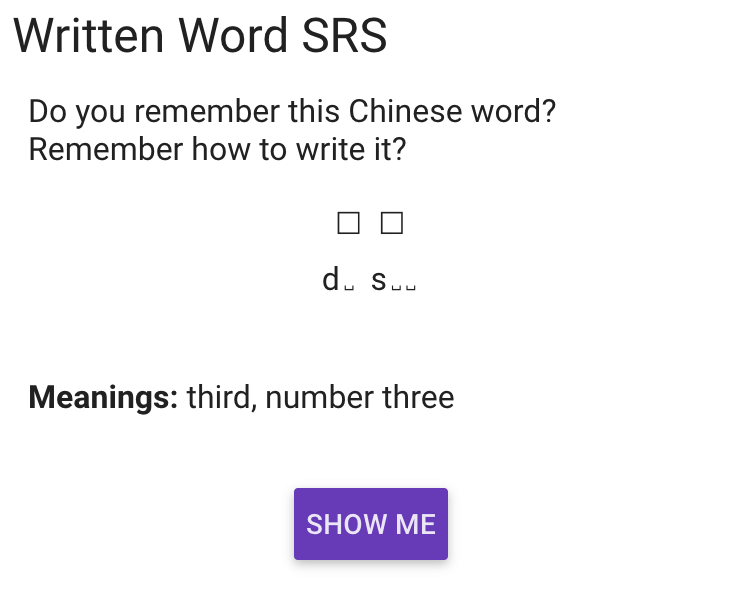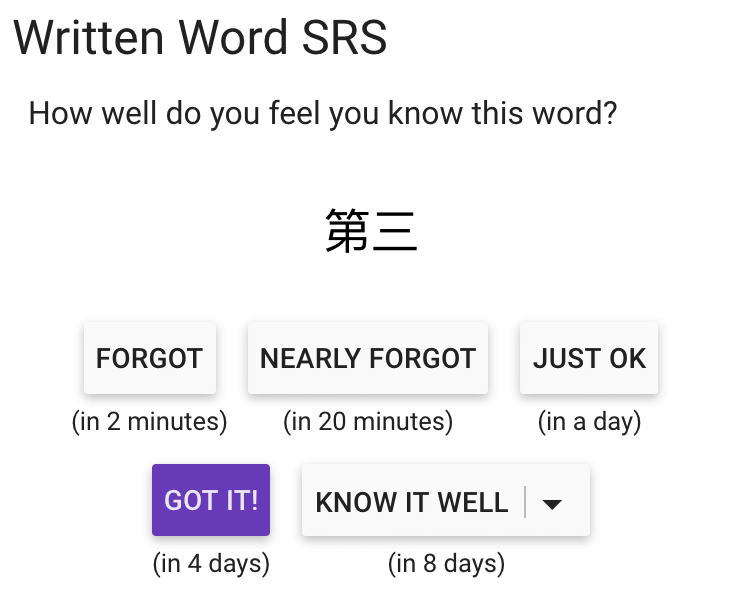The design of a flash card library is intimately tied to what it is meant to practice. What should go on the front of the card? On the back? What does it mean to have remembered it? Flash cards can be used to remember how words are pronounced, what they mean, how to use them, how to write them, how to translate them, and the list goes on. The design of a digital flash card system, is no different.
In the Written Word SRS activity, the front of a card gives you meaning and pronunciation clues about the word so that you can try and think how you would write it:
And the back of the card shows you the answer, i.e., how the word is written, and lets you indicate how well you remembered it, which directly determines when you will review the card next.
In designing our first spaced-repetition flash card activity, we chose a design geared toward a very particular use case: learning and remembering how to write characters. The motivations were several:
- Learning to successfully write a character requires much more attention to its structure than simply learning to recognize it on the page. One notices the repeating motifs that all Chinese characters are composed of and what makes a character distinct from other similar characters.
- Characters quickly fade from memory. Even native speakers suffer from character amnesia. By working character writing practice into your language maintenance routine, you can count on the spaced repetition algorithm to make sure the fraction you forget is limited.
In short, the Written Word SRS gadget is to help you master writing common Chinese characters and to prevent you from forgetting them.
How should I use it? (with pictures)
You will get the most out of this gadget if you use it as intended; the card design, the method for introducing cards, the spaced repetition algorithm and the bonus scheme are all optimized for learning how to master writing Chinese characters. I will explain more below, but first I would like to relate our idea for how it can most effectively be used.
- Practice writing the character or word before you look at the back of the card. You can write the characters into your hand (my preferred strategy), on a piece of paper (making it difficult to cheat), or into the air.
- Learn characters in the context of a few words. This activity uses multi-character words as a way of reviewing the constituent characters. You can facilitate this by introducing a few new words after you introduce a new character. Whenever you introduce a new character, any multi-character words that contain that character (and only others you have already introduced) will be added to the word bank (the set words that are waiting in the wings). The word-bank word with the highest frequency is always introduced next. Since there are likely some common words among the words added when a character is introduced, you can often learn the new character in the context of some words that contain it. The number of words in the word bank is shown in parenthesis on the button labeled “Introduce Word” (pictured below).
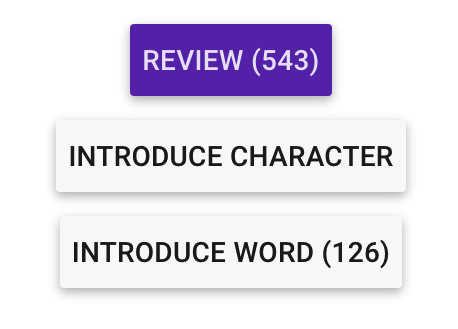
- Balance introductions and reviews. Try and keep a balance between how many new characters you're introducing, the number of words you're introducing, and how many reviews you are doing. At each presentation you get to choose one of these three choices (pictured above). If you introduce too many new characters and words, your review queue will balloon and it will become unmanageable. If you only spend all your time reviewing, you won't be making forward progress learning new characters.
- It's okay to leave a bunch of stuff in your review queue. You don't need to get your review queue back to zero each time you practice. Both the algorithm and the bonus scheme (described below) assume that you often won't do this. I often leave about 100 cards in my review queue. The algorithm is designed to prioritize this pile and is constantly adjusting the sequence to make sure you practice the most important things at the optimal times.
- Keep an eye on the distribution of review intervals. Below the activity we show two histograms (one for characters and one for multi-character words), which give you a sense of how the cards you have introduced are distributed among review intervals. In total there are 12 review intervals, spanning from 2 minutes up to 8 months (roughly in powers of 2). Cards at high levels are ones that are reviewed very infrequently, and so it is normal for these bars to be the longest because they carry the least review burden. In general you will find these plots grow to look like the ones pictured below. You can keep an eye on these, and if the lower half of the plot is looking kind of empty (like in this picture) maybe it's time to introduce more new things rather than simply reviewing cards are at long review intervals.
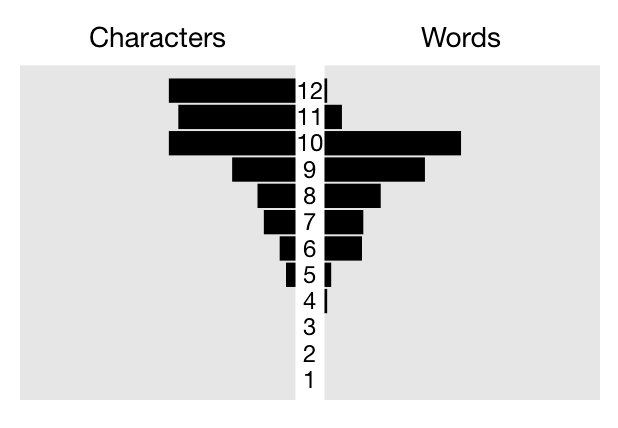
- Bump ahead anything you know well. It takes a lot of time to review cards when you're practicing writing the characters (about 15 seconds per card in our data), and there's no sense in reviewing cards more frequently than necessary. When you see something that you know well, you can use the "know it well" response (or the associated drop down menu) to bump cards up to higher interval durations and thus reduce the overall number of reviews required.
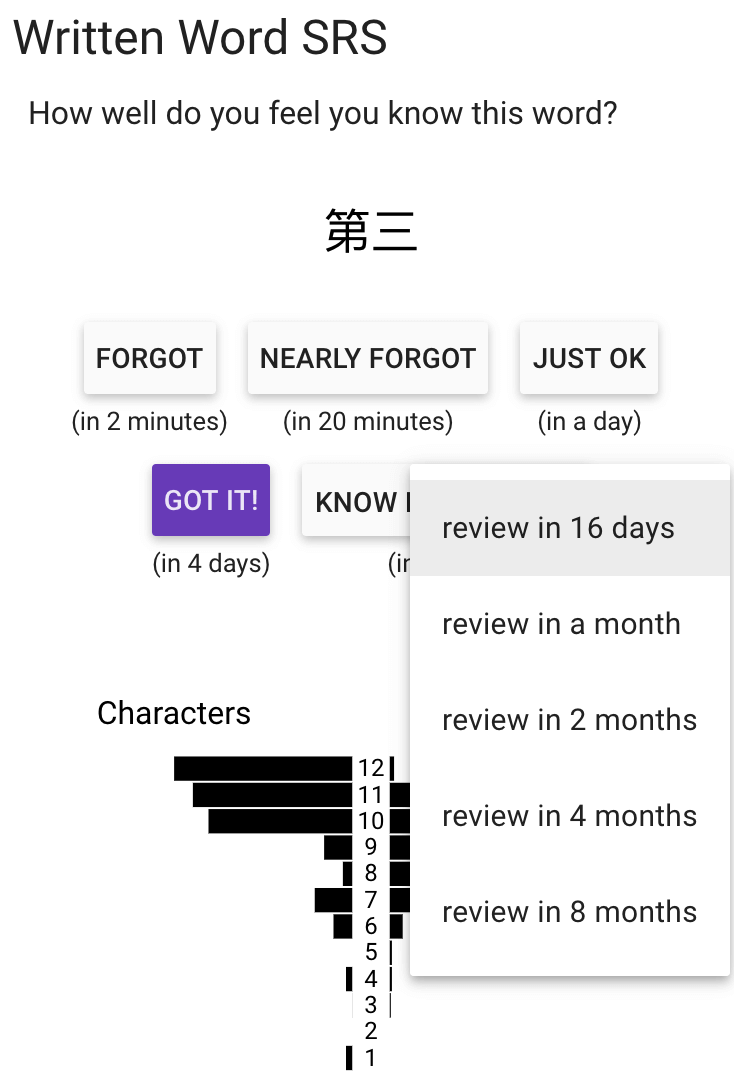
- Use the forget button when you have actually forgotten the card. This will give you a few reviews at short intervals and then return the card back to where it was at (depending somewhat on your subsequent responses). We know you will forget sometimes, and we account for this (more detail in the section "forgetting" below).
The sequence
There are many varieties of spaced-repetition. Here I will describe our particular algorithm so you can decide how best to use it. I will focus on the mode using the “Built-in SRS sequence.”
What we refer to as WordSwing’s Stock List consists of 2928 cards of which 870 are single characters and 2058 are multi-character words that consists of only these 870 characters. The 870 characters are ordered in a sequence that closely follows character frequencies from a corpus of text. In general, the more common characters appear earlier in the sequence, but frequency is not the only determinate. Other factors we incorporated include how many characters are derived using the character as a constituent component (or primitive), and how many other words contain that character. This way you will tend the learn:
- Common characters before rare ones.
- Structurally more fundamental characters before the more elaborate, composite ones.
- Characters that are the basis of lots of words before characters that are used in fewer words.
While this ordering is far from perfect, we hope that it helps make your time well spent.
The timing
There are 12 review interval durations, i.e., the minimum time between reviews of a particular card. These durations start at 2 minutes, followed by 8 minutes, 20 minutes, 1 day, and so on up to a maximum duration of 8 months. If you always select the blue button (often labeled “Got it!”) then a card will tend to pass through each of the 12 levels. As I mentioned above, we encourage you to bump up cards as much as you can while still remembering 80-95%.
The review duration is not exactly the prescribed interval. Instead it is expanded or contracted by a random amount to better mix up the order of cards (so you don’t memorize the sequence as a crutch). Also, cards are reviewed in order of urgency. The urgency score is relative to the interval duration, so if a card is overdue by twice it’s interval then it will tend to be reviewed earlier than a card that is overdue by only 50% of it’s interval, even if the calendar time of the latter review would suggest it should be reviewed first. This has the tendency to prioritize ones you’re most likely to forget so you can get those reviews in sooner rather than later.
There are also two sources of bonuses that allow you to reduce your overall number of reviews without sacrificing learning:
- The first bonus takes advantage of the structure of the language. Remember that this activity is designed for you to master writing the characters, while learning a bunch of vocabulary along the way. If you say you remember a word, such as 朋友, then you also must remember 朋 and 友. Thus you will sometimes (randomly) get credit for either 朋 or 友 when you indicate you remember 朋友.
- The second bonus relates to the timing algorithm. If you’re supposed to review a card after 4 days, but you don’t get around to it until 8 days (because you’re review queue is full of other cards that need to be reviewed more urgently), and you successfully recall the card, you might as well get credit for the 8-day interval rather than the 4-day interval. Thus there is another bonus for this occurrence which reduces your overall number of reviews (and greatly shortens the time it takes to get through the whole sequence, as I describe in the next section).
Forgetting
It’s perfectly natural to forget some cards and we account for this in the timing algorithm. When you tap the “forgot” button, the card will be temporarily returned to the shortest review interval (2 minutes) but a few successful reviews will return it to the interval where you left off. Often this is many fewer reviews than it took to initially reach the point where you forgot it. Thus forgetting it doesn’t mean you need to start from scratch. Instead, you can benefit from the few short intervals to re-solidify the memory, and then pick up where you left off.
Your own word lists
The SRS gadget can also be used with your own word lists, by selecting to start a “custom” study session:

And then selecting the word lists you would like to study:
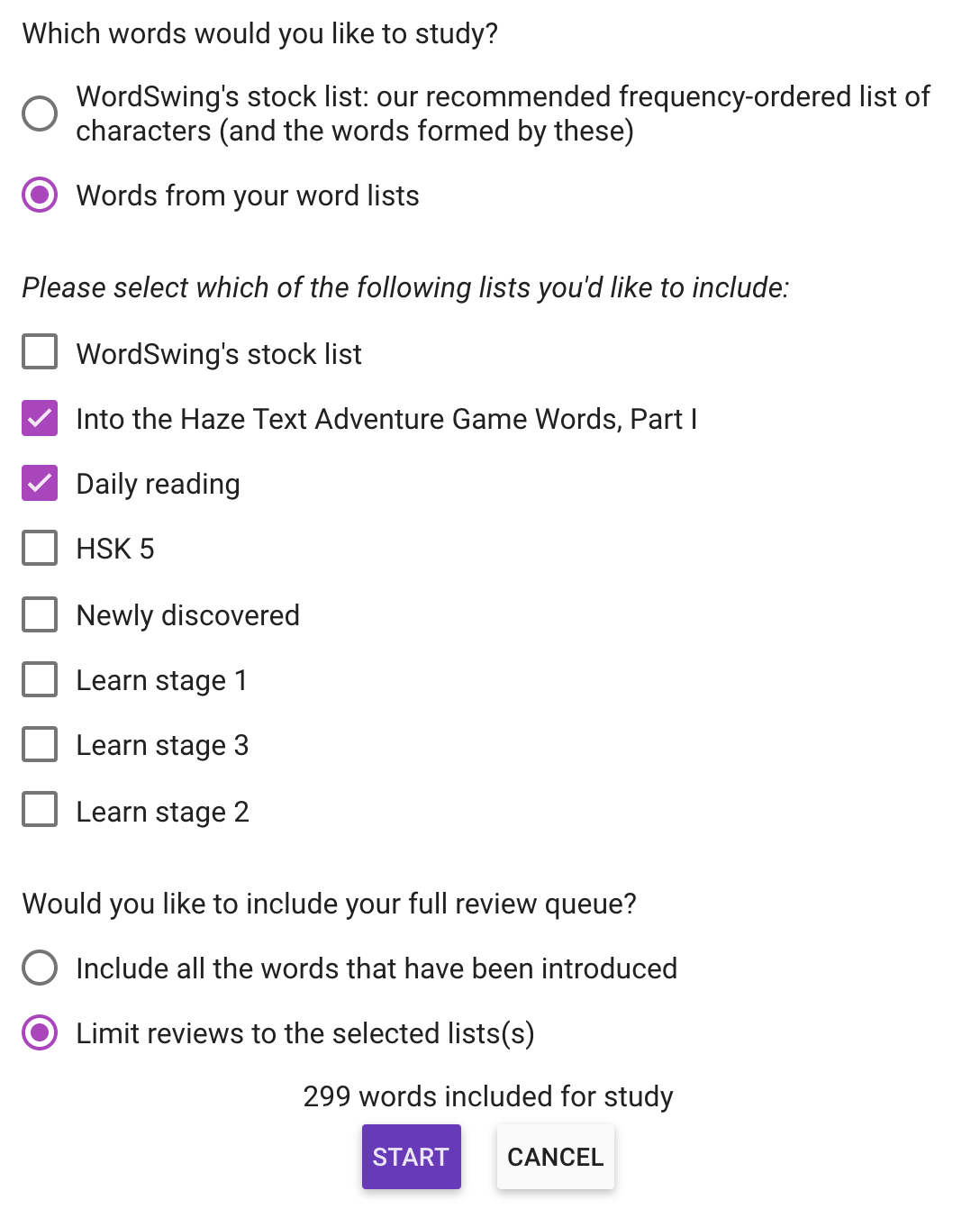
If you want to exclude words that are already in your review queue, but which are not in your selected word lists, please be sure to select the option “Limit reviews to selected lists.”
Alternatives and supplements
Reviewing language using flashcards is a tried and true strategy with many available tools. This particular SRS gadget is just one and it may or may not be suitable for you. And even if it is suitable, it is designed for a particular learning angle (remembering how to write common characters) and there are many other ways in which SRS may be helpful for your learning efforts.
For all these other efforts, we recommend you check out at least two other tools:
